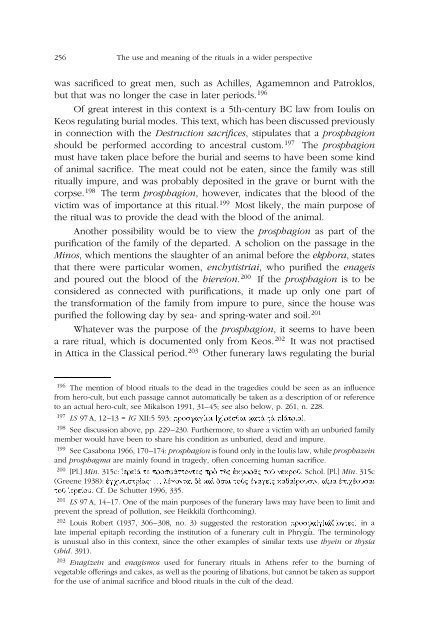The sacrificial rituals of Greek hero cults in the Archaic to the early ...
The sacrificial rituals of Greek hero cults in the Archaic to the early ...
The sacrificial rituals of Greek hero cults in the Archaic to the early ...
Create successful ePaper yourself
Turn your PDF publications into a flip-book with our unique Google optimized e-Paper software.
256 <strong>The</strong> use and mean<strong>in</strong>g <strong>of</strong> <strong>the</strong> <strong>rituals</strong> <strong>in</strong> a wider perspective<br />
was sacrificed <strong>to</strong> great men, such as Achilles, Agamemnon and Patroklos,<br />
but that was no longer <strong>the</strong> case <strong>in</strong> later periods. 196<br />
Of great <strong>in</strong>terest <strong>in</strong> this context is a 5th-century BC law from Ioulis on<br />
Keos regulat<strong>in</strong>g burial modes. This text, which has been discussed previously<br />
<strong>in</strong> connection with <strong>the</strong> Destruction sacrifices, stipulates that a prosphagion<br />
should be performed accord<strong>in</strong>g <strong>to</strong> ancestral cus<strong>to</strong>m. 197 <strong>The</strong> prosphagion<br />
must have taken place before <strong>the</strong> burial and seems <strong>to</strong> have been some k<strong>in</strong>d<br />
<strong>of</strong> animal sacrifice. <strong>The</strong> meat could not be eaten, s<strong>in</strong>ce <strong>the</strong> family was still<br />
ritually impure, and was probably deposited <strong>in</strong> <strong>the</strong> grave or burnt with <strong>the</strong><br />
corpse. 198 <strong>The</strong> term prosphagion, however, <strong>in</strong>dicates that <strong>the</strong> blood <strong>of</strong> <strong>the</strong><br />
victim was <strong>of</strong> importance at this ritual. 199 Most likely, <strong>the</strong> ma<strong>in</strong> purpose <strong>of</strong><br />
<strong>the</strong> ritual was <strong>to</strong> provide <strong>the</strong> dead with <strong>the</strong> blood <strong>of</strong> <strong>the</strong> animal.<br />
Ano<strong>the</strong>r possibility would be <strong>to</strong> view <strong>the</strong> prosphagion as part <strong>of</strong> <strong>the</strong><br />
purification <strong>of</strong> <strong>the</strong> family <strong>of</strong> <strong>the</strong> departed. A scholion on <strong>the</strong> passage <strong>in</strong> <strong>the</strong><br />
M<strong>in</strong>os, which mentions <strong>the</strong> slaughter <strong>of</strong> an animal before <strong>the</strong> ekphora, states<br />
that <strong>the</strong>re were particular women, enchytistriai, who purified <strong>the</strong> enageis<br />
and poured out <strong>the</strong> blood <strong>of</strong> <strong>the</strong> hiereion. 200 If <strong>the</strong> prosphagion is <strong>to</strong> be<br />
considered as connected with purifications, it made up only one part <strong>of</strong><br />
<strong>the</strong> transformation <strong>of</strong> <strong>the</strong> family from impure <strong>to</strong> pure, s<strong>in</strong>ce <strong>the</strong> house was<br />
purified <strong>the</strong> follow<strong>in</strong>g day by sea- and spr<strong>in</strong>g-water and soil. 201<br />
Whatever was <strong>the</strong> purpose <strong>of</strong> <strong>the</strong> prosphagion, it seems <strong>to</strong> have been<br />
a rare ritual, which is documented only from Keos. 202 It was not practised<br />
<strong>in</strong> Attica <strong>in</strong> <strong>the</strong> Classical period. 203 O<strong>the</strong>r funerary laws regulat<strong>in</strong>g <strong>the</strong> burial<br />
196 <strong>The</strong> mention <strong>of</strong> blood <strong>rituals</strong> <strong>to</strong> <strong>the</strong> dead <strong>in</strong> <strong>the</strong> tragedies could be seen as an <strong>in</strong>fluence<br />
from <strong>hero</strong>-cult, but each passage cannot au<strong>to</strong>matically be taken as a description <strong>of</strong> or reference<br />
<strong>to</strong> an actual <strong>hero</strong>-cult, see Mikalson 1991, 31–45; see also below, p. 261, n. 228.<br />
197 LS 97 A, 12–13 = IG XII:5 593:prosfagíwi[q]rêsjaik.atàt .àp[átria].<br />
198 See discussion above, pp. 229–230. Fur<strong>the</strong>rmore, <strong>to</strong> share a victim with an unburied family<br />
member would have been <strong>to</strong> share his condition as unburied, dead and impure.<br />
199 See Casabona 1966, 170–174: prosphagion is found only <strong>in</strong> <strong>the</strong> Ioulis law, while prosphaze<strong>in</strong><br />
and prosphagma are ma<strong>in</strong>ly found <strong>in</strong> tragedy, <strong>of</strong>ten concern<strong>in</strong>g human sacrifice.<br />
200 [Pl.] M<strong>in</strong>. 315c:°ereîáteprosfát<strong>to</strong>ntevpròtævÇkforâv<strong>to</strong>ûnekroû. Schol. [Pl.] M<strong>in</strong>. 315c<br />
(Greene 1938):Çgqutistríav;...légontaidèkaìËsai<strong>to</strong>ùvÇnageîvkajaírous<strong>in</strong>,a´maÇpiqéousai<br />
<strong>to</strong>û°ereíou. Cf. De Schutter 1996, 335.<br />
201 LS 97 A, 14–17. One <strong>of</strong> <strong>the</strong> ma<strong>in</strong> purposes <strong>of</strong> <strong>the</strong> funerary laws may have been <strong>to</strong> limit and<br />
prevent <strong>the</strong> spread <strong>of</strong> pollution, see Heikkilä (forthcom<strong>in</strong>g).<br />
202 Louis Robert (1937, 306–308, no. 3) suggested <strong>the</strong> res<strong>to</strong>ration prosf.a[g]iáz[ontev] <strong>in</strong> a<br />
late imperial epitaph record<strong>in</strong>g <strong>the</strong> <strong>in</strong>stitution <strong>of</strong> a funerary cult <strong>in</strong> Phrygia. <strong>The</strong> term<strong>in</strong>ology<br />
is unusual also <strong>in</strong> this context, s<strong>in</strong>ce <strong>the</strong> o<strong>the</strong>r examples <strong>of</strong> similar texts use thye<strong>in</strong> or thysia<br />
(ibid. 391).<br />
203 Enagize<strong>in</strong> and enagismos used for funerary <strong>rituals</strong> <strong>in</strong> A<strong>the</strong>ns refer <strong>to</strong> <strong>the</strong> burn<strong>in</strong>g <strong>of</strong><br />
vegetable o�fer<strong>in</strong>gs and cakes, as well as <strong>the</strong> pour<strong>in</strong>g <strong>of</strong> libations, but cannot be taken as support<br />
for <strong>the</strong> use <strong>of</strong> animal sacrifice and blood <strong>rituals</strong> <strong>in</strong> <strong>the</strong> cult <strong>of</strong> <strong>the</strong> dead.



